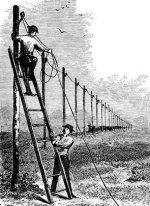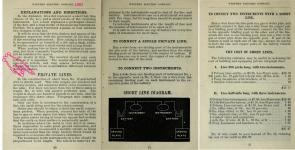In the 1800s there was a massive solar flair that wreaked havoc with the telegraph system, presumably due to the transmission wires. It probably fried a lot of the equipment.
Expand to see wire......telegraph lines across the Philippines. I noticed they were stringing just one wire. I thought "that can't be right,

As you found, it "works". And was the usual pioneer to open new country or when there was a war on.


Downunder, they spanned "3200km through mountains, flood plains and desert with ....almost 3000km of galvanised telegraph wire...", which suggests not only one wire (across some of the driest land on the planet) but they pulled it really really taut. (Or there was an existing short-line?)
Also in Australia there are people, I think one on this forum, who get domestic lighting via one wire and ground. Sounds ridiculous when I bicht about the 0.4 Ohms in my metal power feed.... but if the total ground impedance were 200 Ohms then a 5,600V line would work fine. We have 20,000V at the street, so I could have 4X better power than I have now.
And all this typing took 4X longer than it should have BECAUSE of dam Sam Morse's invention (and what it led to). The cellphone at my elbow KEEPS dinging, some spammer wants me to book a room in a spa, AND the spammer's carrier wants to know what number I am reporting. (Texts are indeed tiny wireless telegrams.) Wireless texting in 1906
Western Electric official advice, 1883

Simplex, duplex, compositing:
https://the-electric-orphanage.com/telegraphy-on-open-wire/

Willow Bunch Telegraph Office
One wire makes a most-of-the-time line. ASAP a "main" line would be upgraded to two conductors. This gives two OK to-ground circuits, plus one full-metallic circuit. Four wires gives four to-ground circuits, two metallic circuits, and one Phantom circuit of half the loss.

Simplex, duplex, compositing:
https://the-electric-orphanage.com/telegraphy-on-open-wire/

Willow Bunch Telegraph Office
One wire makes a most-of-the-time line. ASAP a "main" line would be upgraded to two conductors. This gives two OK to-ground circuits, plus one full-metallic circuit. Four wires gives four to-ground circuits, two metallic circuits, and one Phantom circuit of half the loss.
Last edited:
"...one cup of battery..."
Anyone know what unit is the "cup"? Perhaps it refers to the liquid in the battery.
Anyone know what unit is the "cup"? Perhaps it refers to the liquid in the battery.
Did you notice the cost? Was the conversion to today's dollar done correctly?they spanned "3200km through mountains, flood plains and desert with ....almost 3000km of galvanised telegraph wire...",
Nobody's talking about dynamics. Can a good battery supply provide higher peak currents than a traditional PSU?
I found a text.a scene of stringing telegraph lines across the Philippines. I noticed they were stringing just one wire. I thought "that can't be right, one wire? How's the current going to flow?"
The line is a path over which the telephone current passes from telephone to telephone. The term "telephone line circuit" is equivalent. "Line" and "line circuit" mean slightly different things to some persons, "line" meaning the out-of-doors portion of the line and "line circuit" meaning the indoor portion, composed of apparatus and associated wiring. Such shades of meaning are inevitable and serve useful purposes. The opening definition hereof is accurate.
A telephone line consists of two conductors. One of these conductors may be the earth; the other always is some conducting material other than the earth--almost universally it is of metal and in the form of a wire. A line using one wire and the earth as its pair of conductors has several defects, to be discussed later herein. Both conductors of a line may be wires, the earth serving as no part of the circuit, and this is the best practice. A line composed of one wire and the earth is called a grounded line; a line composed of two wires not needing the earth as a conductor is called a metallic circuit.
In the earliest telephone practice, all lines were grounded ones. The wires were of iron, supported by poles and insulated from them by glass, earthenware, or rubber insulators. For certain uses, such lines still represent good practice. For telegraph service, they represent the present standard practice.
Copper is a better conductor than iron, does not rust, and when drawn into wire in such a way as to have a sufficient tensile strength to support itself is the best available conductor for telephone lines.
Only one metal surpasses it in any quality for the purpose: silver is a better conductor by 1 or 2 per cent. Copper is better than silver in strength and price.
In the open country, telephone lines consist of bare wires of copper, of iron, of steel, or of copper-covered steel supported on insulators borne by poles. If the wires on the poles be many, cross-arms carry four to ten wires each and the insulators are mounted on pins in the cross-arms. If the wires on the poles be few, the insulators are mounted on brackets nailed to the poles. Wires so carried are called open wires.
In towns and cities where many wires are to be carried along the same route, the wires are reduced in size, insulated by a covering over each, and assembled into a group. Such a bundle of insulated wires is called a cable.
Cyclopedia of Telephony and Telegraphy
AMERICAN SCHOOL OF CORRESPONDENCE
1919
https://www.gutenberg.org/1/5/6/1/15617/
https://www.gutenberg.org/ebooks/15617
Last edited:
I have been doing some research on this subject for a hifi setup in my truck camper and from what I understand so far the problem with the battery is voltage sag under load otherwise known as power supply impedance. Could a step down regulator stabilize the voltage ? But how does one design an ultra quiet high current stepdown regulator ? Maybe any regulator noise wouldn't matter if the amp had a well designed CRC filter. Definitely an interesting subject.Nobody's talking about dynamics. Can a good battery supply provide higher peak currents than a traditional PSU?
I believe a simple buck converter would work. I have 12v tvs in my camper and if i turned on the inverter the voltage would sag and the tvs would shut down . A couple $10 buck converters from amazon solved the issue.
Might be a good idea to look at the power supplies in high quality car audio amps?I have been doing some research on this subject for a hifi setup in my truck camper and from what I understand so far the problem with the battery is voltage sag under load otherwise known as power supply impedance. Could a step down regulator stabilize the voltage ? But how does one design an ultra quiet high current stepdown regulator ? Maybe any regulator noise wouldn't matter if the amp had a well designed CRC filter. Definitely an interesting subject.
There is a recent and active thread about this very subject. Seek and ye shall find.
Where?
I am thinking of a Telsa Powerball to power my audio.... Cheaper than a commercial amp...
I could install it by the main panel and energize the homerun line to the stereo. It wouldn't be hard to do...
Ideally, I would bypass the AC... hmm....
Use a Tesla wall battery, or an old submarine battery.
Won't sag. 150Ah inverter or truck battery should also work.
Amp must be appropriate for supply. Car amplifiers should work.
Solar panels to charge.
Common in off grid community.
In India, grid tied solar is becoming very popular, the power generated from home roof tops is fed via an inverter to the grid, and a special meter records how much you generated, and how much you used.
You pay the difference, in some cases the bills are negligible or even negative.
Won't sag. 150Ah inverter or truck battery should also work.
Amp must be appropriate for supply. Car amplifiers should work.
Solar panels to charge.
Common in off grid community.
In India, grid tied solar is becoming very popular, the power generated from home roof tops is fed via an inverter to the grid, and a special meter records how much you generated, and how much you used.
You pay the difference, in some cases the bills are negligible or even negative.
I tried that... priced a system with solar and battery.
The battery per se has sufficient power to satisfy my daily needs but it couldn't be wired into the entire house because of current requirements.
My panel is 300A... so I would have needed like 15 solar batteries to satisfy the MAXIMUM capacity of the system, even though I never reach it.. since I wasn't about to install 15 batteries, I dropped the idea.
But for audio.. well, that's a different thought. Mostly I would like to get a battery with the power and current capacity of a solar battery that outputs suitable DC. Then I can use components such as the preamp and amps that do NOT have a built in AC->DC power supply but instead take DC. And being a BIG battery with 20A current delivery I figure that ought to sound fantastic.
The battery per se has sufficient power to satisfy my daily needs but it couldn't be wired into the entire house because of current requirements.
My panel is 300A... so I would have needed like 15 solar batteries to satisfy the MAXIMUM capacity of the system, even though I never reach it.. since I wasn't about to install 15 batteries, I dropped the idea.
But for audio.. well, that's a different thought. Mostly I would like to get a battery with the power and current capacity of a solar battery that outputs suitable DC. Then I can use components such as the preamp and amps that do NOT have a built in AC->DC power supply but instead take DC. And being a BIG battery with 20A current delivery I figure that ought to sound fantastic.
Here the food cart vendors use solar cells to charge batteries, sometimes they get old car batteries cheap (they won't crank, but at low load they work), and use them to feed LED light strips.
Or they charge them at home, many start sales in the evening, they are at home preparing the items at home (most are final heat and serve type places, the gravies are ready prepared earlier).
There is an enterprising guy who actually gives batteries on rent, 12V/35Ah car batteries mostly.
He drops off charged batteries and takes the discharged ones back to recharge...Charges about 1 USD every time.
Or they charge them at home, many start sales in the evening, they are at home preparing the items at home (most are final heat and serve type places, the gravies are ready prepared earlier).
There is an enterprising guy who actually gives batteries on rent, 12V/35Ah car batteries mostly.
He drops off charged batteries and takes the discharged ones back to recharge...Charges about 1 USD every time.
Once when the power was out after an earthquake, I powered up my little Class-D amp with a solar panel. Direct solar, no battery or even a cap. It did work at low to medium volumes, but the panel was too small to supply enough current for loud music. I was running an OB with horn system. My neighbors came over to ask how we had power. 🙂
- Home
- Amplifiers
- Power Supplies
- Battery Power Our Systems?